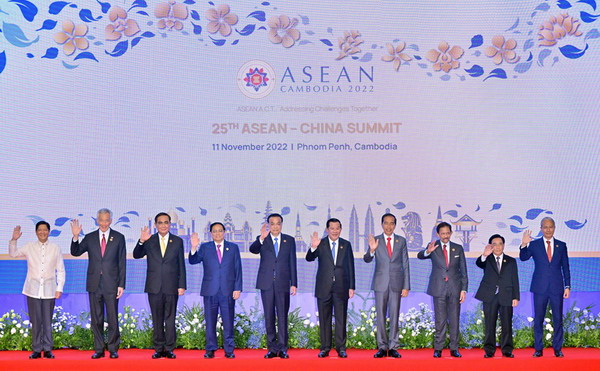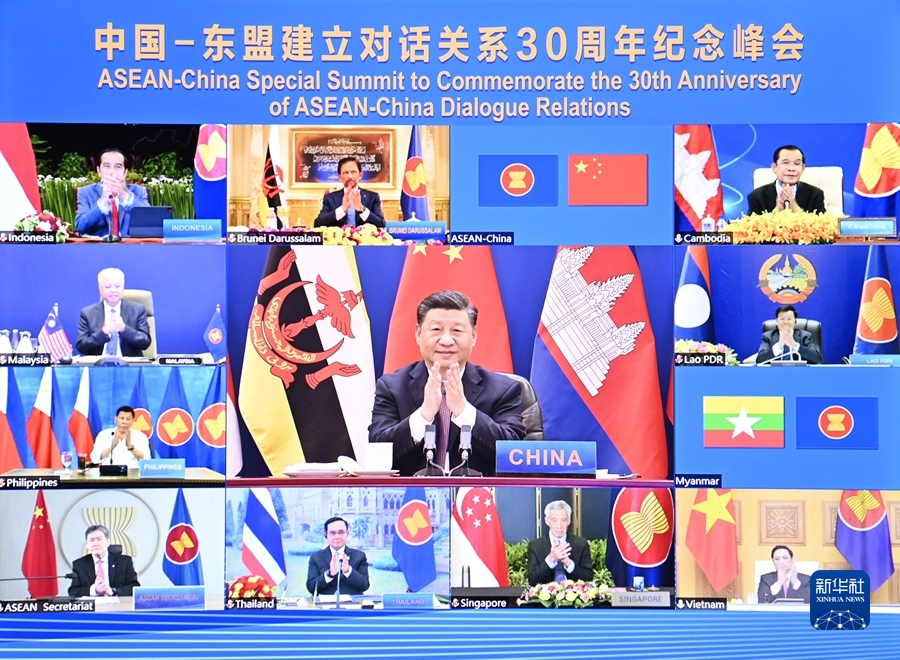|
The new year dawns amidst unprecedented changes in a century, including the COVID-19 pandemic in particular. It will be a milestone year for China and ASEAN, as it ushers in the 30th anniversary of China-ASEAN dialogue relations.
A review of the 30 years unfolds an extraordinary journey defined by tremendous progress. In 1991, China and ASEAN initiated the dialogue process marked by the attendance of the then Foreign Minister Qian Qichen at the Opening Ceremony of the 24th ASEAN Foreign Ministers’ Meeting. In 2003, China acceded to theTreaty of Amity and Cooperation in Southeast Asia, ASEAN’s first dialogue partner to do so, and established China-ASEAN strategic partnership, which was again a trailblazing endeavor.
In 2010, China-ASEAN Free Trade Area was up and running. In 2013, President Xi Jinping proposed to jointly build a closer China-ASEAN community with a shared future during his visit to ASEAN countries. In 2018, the China-ASEAN Strategic Partnership Vision 2030 was issued, a blueprint eyeing the future. Last year after COVID-19 hit us all, China and ASEAN stood in firm solidarity to fight the virus, resume growth and protect people’s livelihood.
Among ASEAN’s dialogue partners, China has been number one on many fronts, which enables our relations to be proudly defined as comprehensive, pioneering and creative. Just as President Xi said in the 17th China-ASEAN Expo & China-ASEAN Business and Investment Summit late last year, “China-ASEAN relationship has grown into the most successful and vibrant model for cooperation in the Asia-Pacific and an exemplary effort in building a community with a shared future for mankind.”
Yet besides the ever-growing momentum, there are things that remain unchanged between China and ASEAN in 30 years. First, the shared commitment to peaceful development and good neighborliness. Both China and ASEAN are convicted that prosperity is nowhere to be found without peace and stability. As permanent neighbors and close partners, China and ASEAN countries hold dear the tradition of mutual respect and mutual assistance and the wisdom of seeking common ground while shelving differences and resolving disagreements through dialogue and consultation.
Second, the shared commitment to common development and win-win cooperation. While China has remained ASEAN’s largest trading partner for 11 consecutive years, ASEAN surpassed the European Union last year to be China’ s largest trading partner for the first time in history.
Third, the shared commitment to multilateralism, openness and inclusiveness. ASEAN is tremendously inclusive as a regional organization that well accommodates political systems, religions and cultures that cannot be more different. Multilateralism is in the genes of ASEAN. China has been firmly committed to supporting ASEAN centrality in regional cooperation and ASEAN’s greater role in building an open and inclusive regional architecture. No matter what happens to international and regional landscape, it has been a solid consensus between China and ASEAN to choose solidarity over division, openness over isolation and cooperation over confrontation.
The year 2021 means a lot for both China and ASEAN. It is the centenary year for the Communist Party of China, the first year for China’s 14th Five-Year Plan to be rolled out, and the start of China’s new journey to fully build a modern socialist country. For ASEAN’s part, it has been halfway through the ASEAN Community Vision 2025, with significant achievements in the community-building of three pillars. ASEAN is preparing itself in every way for bigger progress. And the special juncture coincides with the 30th anniversary of China-ASEAN relations, a new starting point brimmed with new opportunities. Here are some highlights of the year that could be most expected.
First, China-ASEAN high-level exchanges will continue to guide our way forward. China looks forward to carrying out a number of events with ASEAN to celebrate the 30th anniversary. Our leaders will, as always, be engaged in close interactions and guide strategically. The most recent engagement is taking place this week, with State Councilor and Foreign Minister Wang Yi visiting four ASEAN Member States, i.e. Myanmar, Indonesia, Brunei and the Philippines. China-ASEAN relationship is among the top priorities of his agenda. China is committed to doing its utmost to safeguarding peace and stability of the South China Sea by deepening mutual trust, promoting cooperation and managing differences with relevant ASEAN countries.
Second, public health cooperation will be deepened to end the pandemic at an early date. China is actively exploring R&D and production cooperation on vaccines with ASEAN. As a total of 3 million doses of vaccines developed by Sinovac Biotech arrived in Indonesia recently, China will continue to take real actions to make COVID-19 vaccines more affordable and accessible for the peoples of the region. China will work with ASEAN to enhance joint pandemic response, including setting up reserves of medical supplies and a liaison mechanism for public health emergencies, and help strengthen ASEAN’s public health performance, such as in personnel training, resource allocation and capacity building.
Third, China and ASEAN need to keep the strong momentum of economic cooperation and accelerate regional economic recovery. We would work for the early entry into force of theRegional Comprehensive Economic Partnership (RCEP), seek greater synergy in our policies for economic recovery, expand the scope of “fast tracks” for travel and “green lanes” for cargo transportation in a well-thought-out way, and implement the China-ASEAN Free Trade Agreement and its upgraded Protocol. We will also promote high-quality Belt and Road cooperation by ensuring steady progress in key projects, including the China-Laos Railway, China-Thailand Railway and the Jakarta-Bandung Railway, to enhance local infrastructure connectivity. We will seize the opportunities of digital economy and cultivate new cooperation areas in e-commerce, big data, 5G and smart cities.
Fourth, creative efforts will be made to boost people-to-people exchanges and sustainable development. Flagship projects such as the China-ASEAN Young Leaders Scholarship and China-ASEAN Short Video Contest will expand new fronts of connections between the people. As 2021 is also China-ASEAN Year of Sustainable Development, China wishes to increase cooperation with ASEAN in poverty reduction, environmental protection, disaster relief, climate change, among others, and explore the establishment of the blue economic partnership.
Sunshine will eventually dispel the shadows, and spring isn’t far behind. As we usher in the historic year of the 30th anniversary of China-ASEAN relations, we are ready to ride on the rising tide and build a closer China-ASEAN community with a shared future!
The article is written by Mr. Deng Xijun, Ambassador of the People’s Republic of China to ASEAN.
|











